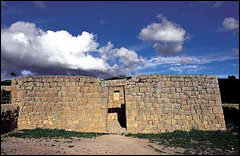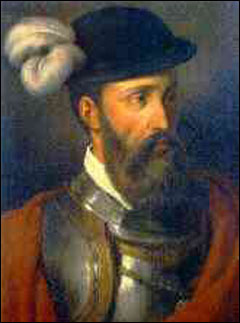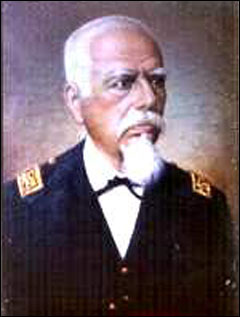 HISTORY HISTORY |
Inca Empire
Advanced indigenous cultures such as the Chorrera,
Jama Coaque, Bahia, Tolita, Machalilla and Valdivia
(the oldest known culture in the Americas), flourished
in Ecuador long before the area was conquered
by the Inca empire in the 15th century. The earliest
historical details date back only as far as the
11th century AD. It is commonly believed that
Asian nomads reached the South American continent
by about 12,000 BC and were later joined by Polynesian
colonizers. Centuries of tribal expansion, warfare
and alliances resulted in the relatively stable
Duchicela lineage, which ruled more or less peacefully
for about 150 years until the arrival of the Incas
around 1450 AD.

The Incas, the largest culture, originally from
the central regions of what today is Peru, assimilated
the rest in the north. The Incas were made up
of a vast population of dozens of different ethnic
groups with their own languages, customs and economies
based on cultivation of the land.
The Incan Empire, consolidated by Huayna Capac,
dominated most of western South America between
the later half of the 15th century and 1520. He
died in 1526, after dividing the empire between
his two sons. Cuzco was assigned to Huáscar
and Quito to Atahualpa. Shortly thereafter, a
fratricidal struggle took place weakening imperial
power and inadvertently facilitating the Spanish
conquest.
 Spanish Domination
Spanish Domination
|
The first Spaniards landed in northern Ecuador
in 1526. Pizarro reached the country in 1532 and
spread terror among the Indians thanks to his
conquistadors' horses, armour and weaponry. Atahualpa
was ambushed, held for ransom, 'tried' and executed,
and the Inca empire was effectively demolished.
Quito held out for two years but was eventually
razed by Atahualpa's general, Rumiñahui,
rather than be lost intact to the invading Spaniards.
Quito was refounded in December 1534.

The indigenous population was decimated by disease
in the first decades of Spanish rule, a time when
the natives also were forced into the "encomienda"
labor system for Spanish landlords. The Real Audiencia
de Quito was established in 1563, as an administrative
area dependent on the Spanish Crown. From its
beginning until the XVIII century, it was part
of the Viceroyalty of Peru.
The Spanish maintained strict control and had
authority over Ecuador for 250 years. The Spanish
laws, customs and ideas were introduced to the
locals who began to mix the old traditions with
the new. The Quitenian School of Art was born
reflecting the fusion between cultures. The Christian
art shows the religious figures emerged in pre-colonial
traditions including a picture of the last supper
with Cuy (Guinea Pig) served as the main dish.
This artwork is present today and can be viewed
in the religious architecture, sculptures, and
paintings created during the sixteenth, seventeenth
and eighteenth centuries around the country.
 Independence Independence |
Independence came about between the end of the
XVIII century and the early decades of the XIX
century. Various factors are attributed to the
fall of the colonial system. First, social decadence
sped up in the second half of the XVIII century.
Second, the influence of the French Revolution
in the region. Finally, the power of the private
elite was also limited by reforms which were introduced.
The people were no longer happy being a colony
working for Spain. They wanted freedom.
Simon Bolivar emerged as a leader guiding them
down the path to independence. He dreamed of creating
an independent and United Spanish America. On
August 10th, 1809 Quito became "The Luz de
America" the first place to declare independence
from Spain. One of Bolivar's generals and statesmen
Antonio Jose de Sucre led the country's fight.
For 13 long years the war continued as Sucre led
the troops into battle against the Spanish Royalist
Army.
Bolivar's vision was to unite Venezuela, Colombia
and Ecuador to form a federation called Gran Colombia
but this independent nation of unity lasted only
for 8 years until Ecuador took full independence
on its own in 1830.
 The
republic of Ecuador The
republic of Ecuador |
Since full constitutional sovereignty was gained
in 1830, the country's internal history has since
been marked by fierce rivalry and occasional open
warfare between the church-backed conservatives,
based in Quito, and the liberals and socialists
of Guayaquil. Political turmoil and the desire
for a global economy have portrayed Ecuador's
history. There have been 86 changes in government
since becoming a republic, each regime averaging
a 1.75 years.
The 19th century was marked by instability, with
a rapid succession of rulers. The conservative
Gabriel Garcia Moreno unified the country in the
1860s with the support of the Catholic Church.
In the late 1800s, world demand for cocoa tied
the economy to commodity exports and led to migrations
from the highlands to the agricultural frontier
on the coast.
A coastal-based liberal revolution in 1895 under
Eloy Alfaro reduced the power of the clergy and
opened the way for capitalist development. The
end of the cocoa boom produced renewed political
instability and a military coup in 1925. The 1930s
and 1940s were marked by populist politicians
such as five-time president Jose Velasco Ibarra.
|

In 1941, neighboring Peru invaded Ecuador and
seized much of the country's Amazonian area. The
'new' border between the two countries - initially
agreed upon and ratified by the 1942 Rio de Janeiro
treaty - was finally recognized by both counties
in a 1998 treaty.
After the second world war around 1948-60, a
recovery in the market for agricultural commodities
and the growth of the banana industry helped restore
prosperity and political peace. The country also
had three successive President whom all ran their
full terms of office giving stability to the political
system through the respected democracies.
Recession and popular unrest led to a return
to populist politics and domestic military interventions
in the 1960s, while foreign companies developed
oil resources in the Ecuadorian Amazon. In 1972,
a nationalist military regime seized power and
used the new oil wealth and foreign borrowing
to pay for a program of industrialization, land
reform, and subsidies for urban consumers. With
the oil boom fading, Ecuador returned to democracy
in 1979.
 Recent
years Recent
years |
In 1978 a new constitution was passed and the
following year Ecuador returned to democracy with
the election of Jaime Roldós (Concentración
de Fuerzas Populares, populist party) although
this particular president met his death in an
a plane crash in 1981 but the party completed
its term in office till 1984 under Oswaldo Hurtado
(Democracia Popular, social democrat).
The 1984 presidential elections were narrowly
won by Leon Febres-Cordero of the Social Christian
Party (PSC). During the first years of his administration,
Febres-Cordero introduced free-market economic
policies, took strong stands against drug trafficking
and terrorism, and pursued close relations with
the United States. His tenure was marred by bitter
wrangling with other branches of government and
his own brief kidnapping by elements of the military.
A devastating earthquake in March 1987 interrupted
oil exports and worsened the country's economic
problems.
Rodrigo Borja of the Democratic Left (ID) party
won the presidency in 1988. His government was
committed to improving human rights protection
and carried out some reforms, notably an opening
of Ecuador to foreign trade. The Borja government
concluded an accord leading to the disbanding
of the small terrorist group, "Alfaro Lives."
However, continuing economic problems undermined
the popularity of the ID, and opposition parties
gained control of congress in 1990.
In 1992, Sixto Duran-Ballen won in his third
run for the presidency. His government succeeded
in pushing a limited number of modernization initiatives
through Congress. Duran-Ballen's vice president,
Alberto Dahik, was the architect of the administration's
economic policies, but in 1995, Dahik fled the
country to avoid prosecution on corruption charges
following a heated political battle with the opposition.
A war with Peru erupted in January-February 1995
in a small, remote region where the boundary prescribed
by the 1942 Rio Protocol was in dispute.
Abdala Bucaram, from the Guayaquil-based Ecuadorian
Roldosista Party (PRE), won the presidency in
1996 on a platform that promised populist economic
and social policies and the breaking of what Bucaram
termed as the power of the nation's oligarchy.
During his short term of office, Bucaram's administration
drew criticism for corruption. Bucaram was deposed
by the Congress in February 1997 on grounds of
alleged mental incompetence. In his place, Congress
named interim President Fabian Alarcon, who had
been president of Congress and head of the small
Radical Alfarist Front party. Alarcon's interim
presidency was endorsed by a May 1997 popular
referendum.
Quito Mayor Jamil Mahuad of the Popular Democracy
party won presidential elections on August 10,
1998. On the same day, Ecuador's new constitution
came into effect. Mahuad concluded a well-received
peace with Peru on October 26, 1998, but increasing
economic, fiscal, and financial difficulties drove
his popularity steadily lower.
In an attempt to stop the decline of Ecuador's
currency, the sucre, which lost 75% of its value
in less than a year, soon-to-be deposed president
Jamil Mahuad made an unpopular announcement on
January 10th that he would 'dollarize' the economy,
replacing sucres with US dollars at a rate of
25,000 sucres per dollar. Thousands of non-violent
protestors, including many indigenous leaders
denouncing neoliberal economic policies, subsequently
occupied government buildings in Quito and forced
Mahuad's resignation.
Mahuad's vice-president, Guastavo Noboa, took
office on January 22, 2000. Noboa was presented
as one of the few honest politicians in a country
where political corruption is the norm, although
his political experience was minimal. His first
comments were that he would eliminate political
corruption and that he agreed with dollarization.
Noboa has continued apace with implementation
of dubious International Monetary Fund (IMF) economic
'structural adjustment' policies, in the face
of increasing indigenous and working class opposition.
On January 21, 2000, during demonstrations in
Quito by indigenous groups, the military and police
refused to enforce public order. Demonstrators
entered the National Assembly building and declared
a three-person "junta" in charge of
the country. Field-grade military officers declared
their support for the concept. During a night
of confusion and negotiations, President Mahuad
was obliged to flee the presidential palace. Vice
President Gustavo Noboa took charge; Mahuad went
on national television in the morning to endorse
Noboa as his successor. Congress met in emergency
session in Guayaquil the same day, January 22,
and ratified Noboa as President of the Republic
in constitutional succession to Mahuad.
The new president, Coronel Lucio Gutierrez, took
office on January 15th 2003. Soon later an agreement
with the IMF was signed. The minority of congressmen
whose parties backed Mr Gutierrez's successful
presidential bid are outnumbered by representatives
of the largest party in the legislature, the Partido
Social Cristiano (PSC), and other traditional
political parties.
|

